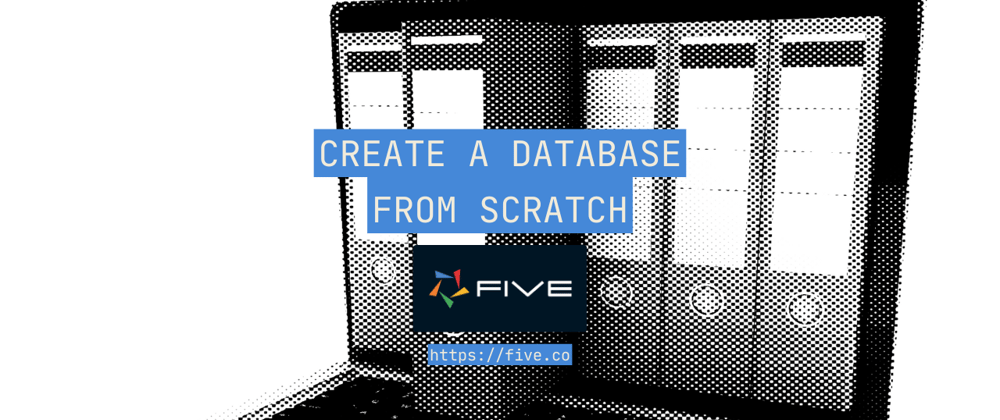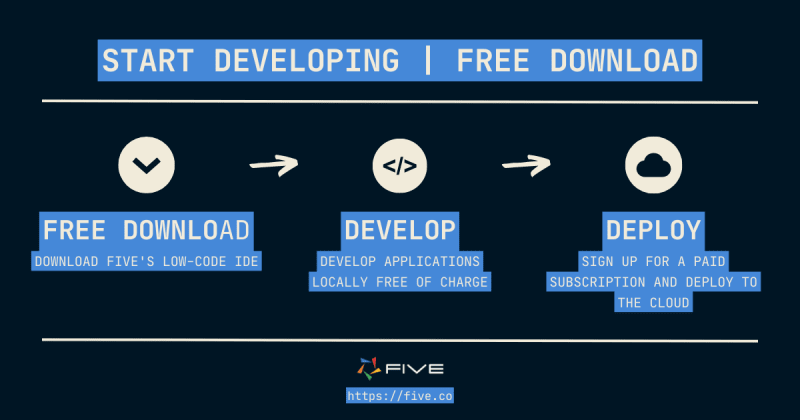There are a lot of different ways to build a database from scratch. Here we explore the easy way, using Five, a database application builder that replaces traditional, more coder-heavy database administration tools, such as MySQL Workbench or phpMyAdmin with a more user-friendly interface.
In addition to letting users create a database from scratch, Five also offers many other application development features, from creating forms on top of a database to generating charts, dashboards, or reports.
If you are a first-time user of Five, the platform, just like any new development environment, might seem a little intimidating at first. So, let's review some of the core concepts to make your first experience in Five successful and fun!
Step 1: Downloading & Installing Five
First things first: make sure to have Five installed on your computer. To access our free download, sign up and follow the installation. The download can take a bit of time, as Five is a large file, so sit back and check in again every few minutes to see if it is complete.
Build A Database from Scratch
Download Five for Free and Start Developing
Remember, you don't have to pay anything to develop database applications with Five. You only have to subscribe to one of our paid plans if you decide to host your application on Five's managed cloud, which gives you a custom URL to access your application or share it with your application users. This makes Five a great tool for learners or those who simply want to explore a database software.
After signing up for our free download, make sure to check your email box (including your spam folder) for an email from noreply@five.co. This email contains your personal serial number required to activate your free download.
Once installed, launch Five. Now you are up and running and it's time to start building!
TIP: Our User Community
If at any point you are hitting a roadblock or don't know how to continue, check out our user community. Here you can find answers to the most common questions that people have when using Five. And, of course, you can get advice from our experts on how to build applications with Five.
Step 2: Start Developing
Five is running on your machine and you're ready to delve into your first app development project! What's the best place to get started?
Follow our YouTube tutorial on how to build a membership application! This seven-step tutorial will take you through the entire process of building an app with Five, from database modeling to previewing your finished application locally.
https://www.youtube.com/watch?v=jcRAhyw9rmI&list=PLerqEA4wsHa2vY5vW3fK1Nkl4Npxn5MKQ
Step 1 of our YouTube tutorial explains how to create a database table in Five. So if your primary goal is creating a database from scratch, then watching this four-and-a-half-minute video is time well spent!
The video also shows how to assign different SQL data types to your table fields, as well as how to inspect your database schema visually using Five's database modeler. It also explains how Five automatically adds primary keys to all your tables.
Last, by watching the video series, you'll gain a better understanding of how Five translates your database into an intuitive, auto-generated front-end. This makes Five a great tool for all those who want to build a database from scratch, and then build a graphical user interface-end on top of it. Five's auto-generated front-end comes with a search bar, forms, filters, and edit buttons.
A Note on Primary Keys and Foreign Keys in Five
The primary keys that Five adds to your tables are Globally Unique Identifiers (GUIDs), 128-bit text strings that represent an identification. GUIDs are great primary keys because the odds of two GUIDs colliding are one in 2¹²², which is a phenomenally small number. So don't worry about creating your own primary keys. Five manages this part for you.
If you would like to create related tables, then Five can also be used to add a Foreign Key to another table. Simply use Five's Table Wizard to do so.
Step 3: Where to Find Help
Any new tool comes with a learning curve and so does Five. For those already familiar with SQL, Five is quite intuitive. Five heavily relies on standard SQL concepts, such as relationships, primary and foreign keys, data views and queries.
For those new to relational databases or those who are creating their very first database from scratch, the learning curve can be a bit steep at the start. So, where can we find help if we don't know how to continue?
We have already mentioned our user community and our YouTube channel as two places with many helpful resources.
On top of this, there is a lot of in-product help in Five. To access the help and documentation, simply click on the Help icon in the top right corner. You may not find an answer to your every question, but the help is quite comprehensive and covers a lot of the most commonly asked questions.
On top of that, many of Five's fields are documented and have a little help text that can be accessed when hovering on a field, and then clicking View help. Check out the image below to see where the Help buttons are located in Five.
Step 4: Launching Your Application
If you are only using Five to create a database from scratch, then you will primarily use Five's Data features, which let you create your database, add tables and fields, and inspect your database schema visually.
But this is just one of Five's features: you can build entire database-driven applications with Five.
For example, use Five to build a front-end on top of your MySQL database and turn your database into a modern web app. Or convert an Excel sheet into a web app using Five's Import Data feature. There are plenty of features in Five that let you add more and more features to your database. To follow along, keep watching the YouTube playlist linked at the top!
Last but not least, there are two more important things to know about Five.
1. You can always preview your application by clicking the Run button in the top right corner of Five.
2. You have used Five to create a database from scratch and have developed an application on top of it? Then it's time to launch your application to the web!
To do so, sign up for one of our hosted plans, starting from as little as US$27.49 per application and month, and get a hosted, fully-provisioned database and a custom URL for your web app.
Step 5: Working With Templates and Getting Inspiration
If you are building a database from scratch, thinking of your database schema is probably the hardest part. As a wise developer once said: there is no good application without a good database.
To provide some inspiration, check out our use cases, some of which come with template applications (and we're adding more and more templates weekly). By importing one of our template applications into Five, you can take a shortcut to your development and build on top of what the template already provides.
We also provide free themes which can be used to customize the way your application looks.
Five can be used to build any kind of data-driven web app: from inspection checklists to complex custom-built inventory systems.
Share your use case with us on the forum, and we're happy to guide you in your development journey!











Top comments (0)